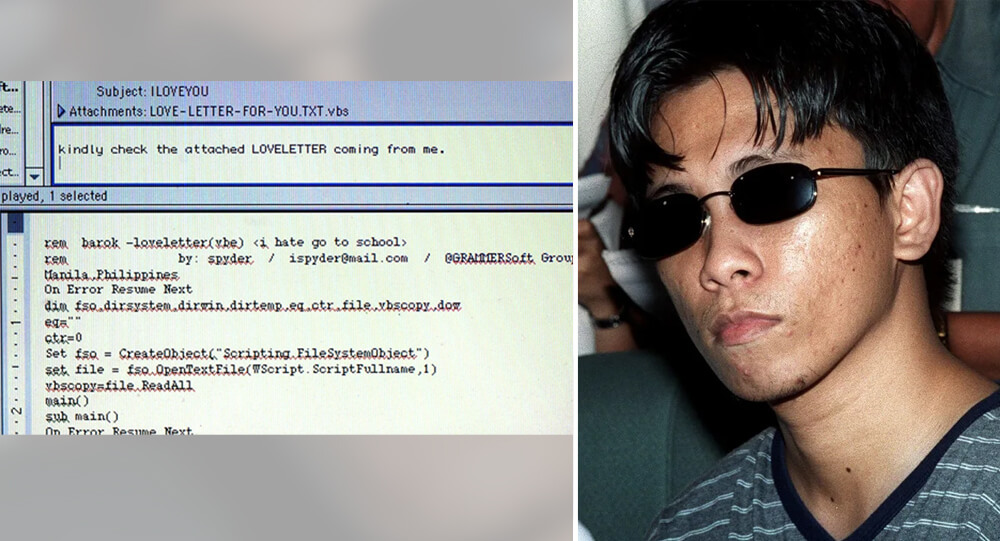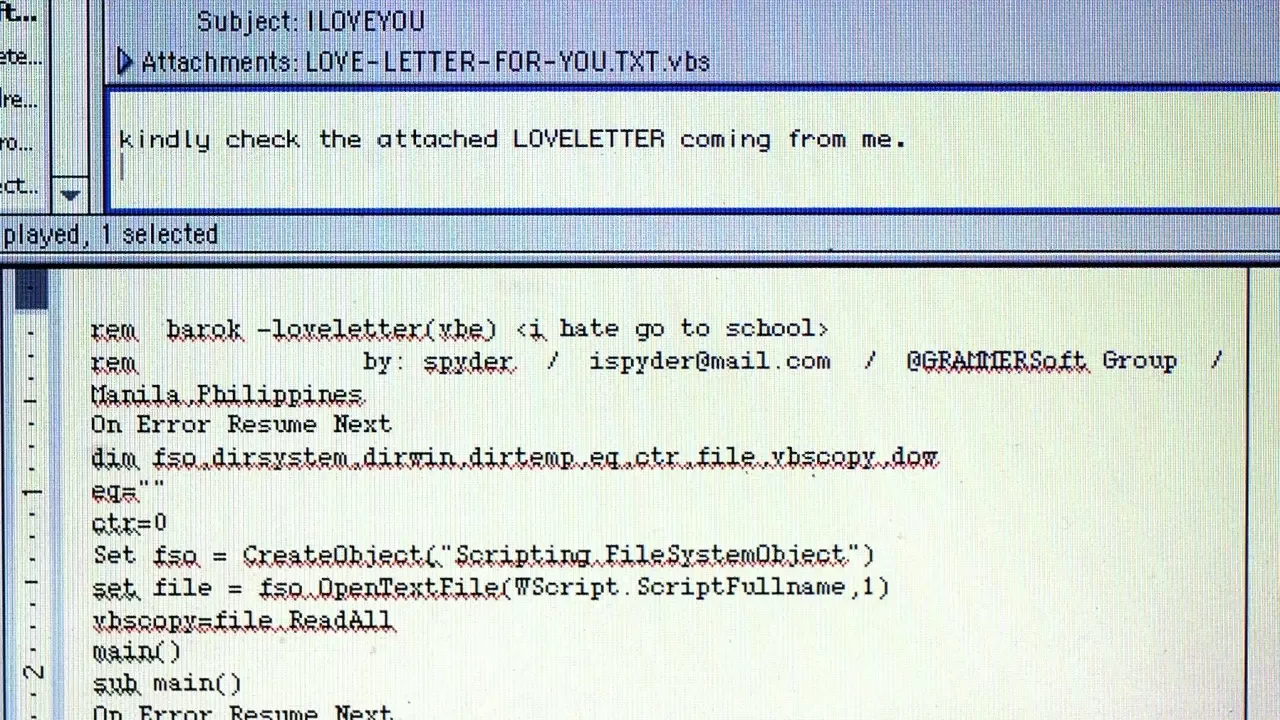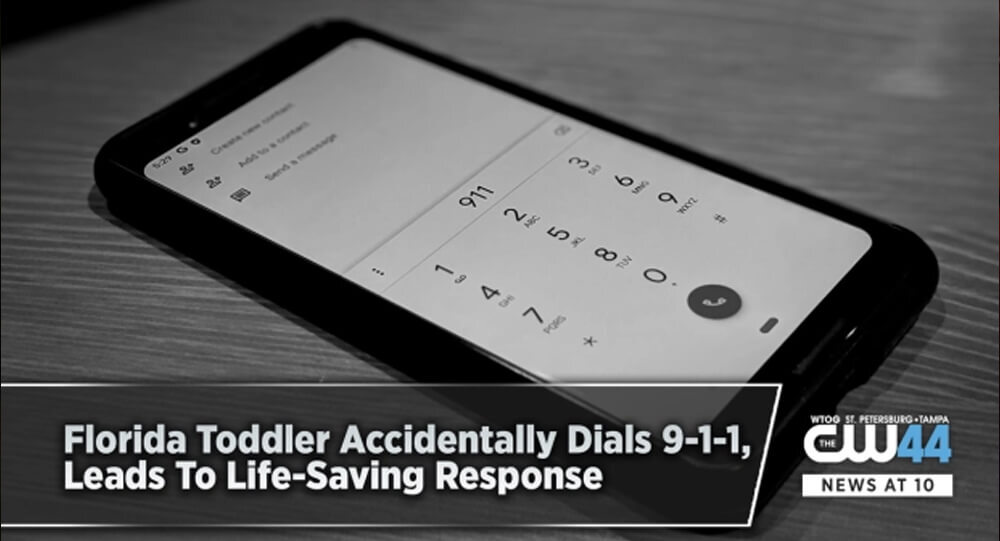
Many early Internet users were concerned about their safety due to the ILOVEYOU Virus, also known as Love Letter for You or Love Bug. Due to its capacity to replicate email address book entries, this virus, like the Melissa Virus, had a high infection rate. Despite the virus appearing to be ancient history, its notoriety endures to this day.
Cybersecurity experts understand the need to learn from previous threats as hacker groups create more complex and occasionally evasive viruses. We can learn valuable lessons from this instance of malicious code that was first disseminated through email attachments. Before choosing to download, computer users can learn more about this virus and its effects by reading the following paragraphs.

What is the ILOVEYOU Virus?
Onel de Guzman, a college student in Manilla, Philippines, in the year 2000, is credited with creating the worm-like virus known as the ILOVEYOU Virus. De Guzman developed the virus at the time using hacker techniques to steal passwords from Internet users. Onel de Guzman used his belief that people shouldn’t have to pay for Internet access as justification for developing the malware.
When opened, the virus would activate a Visual Basic script to damage files by deleting or overwriting them, frequently including images and Office files. This virus would start with an email using the subject line “ILOVEYOU” and an attachment titled “LOVE-LETTER-FOR-YOU.TXT.vbs.”

One of the Internet’s fastest-spreading viruses, it would send itself as an email attachment to each and every address in your Outlook address book. At first, prevention measures were not implemented because so many people acquired the infected attachment from acquaintances.
Once the virus got into corporate email accounts, it took a lot of time and money to try to get rid of it. The British Parliament, the CIA, and the Pentagon were among the government organizations that had to shut down their email systems in order to get rid of the virus.
Up to 50 million computers—or 10% of all computers connected to the Internet at the time—became infected. Over $8 billion was spent globally on virus-related damages, and up to $15 billion was needed for repairs. One of the worst computer-related catastrophes in recorded history was a result of this malicious code.

How Do You Tell If You Have the ILOVEYOU Virus?
In addition to having received an email and attachment that indicate you have the virus, there are other signs of the ILOVEYOU Virus to watch out for. Although this threat to online security is more of a form of malicious code than a full-fledged virus, it exhibits symptoms that leave behind traces.
Receiving emails with attachments that you did not intend to send to each of your contacts is one of the infection symptoms that is fairly obvious. One thing to keep in mind is that many hackers started using variations of the original subject header or file name to avoid being discovered. The effects and potential for damage do not change even though this information may change.
Additionally, the malware could delete audio files, images, and other types of image files. One of the worst aspects of the situation was that, in the absence of backups, the virus led to the loss of a significant amount of data. One of the biggest issues for businesses when the virus first appeared was the potential for other types of files to be deleted or modified.
The virus was also capable of altering specific settings in the computer’s Registry file, changing the Internet Explorer start page in unfavorable ways, and disseminating itself via Internet Relay Chat. Prevention is essential to reducing potential losses when a virus or worm is this troublesome.
What Can This Virus Do to Your System?
Effective antivirus software is even more crucial because this virus can be very disruptive even though it is unlikely to harm your system permanently. At its worst, this worm forced users to download fresh copies of files that had been corrupted or destroyed. These files were permanently lost in some instances.
Onel de Guzman assisted in laying the groundwork for hackers to produce malicious code that was spread through email attachments and was more difficult to eradicate, even though the creator may not have intended to cause such widespread disruption. A more widespread understanding of the necessity for Internet users to adhere to fundamental safety precautions was one of the more positive outcomes.

The actions of a 7-year-old girl protected her mother from bullets
A 7-year-old girl jumped in front of her mother to save her from a man who was attempting to kill her in 2007. She was shot six times and survived, as well as saving her mother.

The rescuing hug - the touching story of twins Brielle and Kyrie Jackson
Brielle and Kyrie Jackson’s lifesaving hug was captured when Brielle was struggling to breathe and going blue. As a final option, the nurse deviated from protocol and placed them in the same incubator. Kyrie wrapped her arm around her sister, who immediately began to stabilize

Hyperinflation of the Zimbabwe dollar turning phasing out their local money in 2015
Hyperinflation of the Zimbabwe dollar made it one of the lowest valued currencies in the world. So the country abandoned it in 2009, and switched to using foreign money. In 2015, to complete the process of phasing out their local money, the government offered to exchange it at a rate of one US dollar for 35 quadrillion Zimbabwean dollars.

Timothy Ray Brown, who inspired millions of HIV-positive people, died of leukemia
Timothy Ray Brown, also known as "The Berlin Patient," was the first person to be HIV-free. He was diagnosed with leukemia in 2006 and had a bone marrow transplant in 2007 as part of his treatment. The transplant helped him overcome the otherwise incurable disease thanks to the rare, HIV-resistant donor.

Man's Blood Helped Save Millions of Babies
Australian blood donor James Harrison has been one of our most impressive and valued donors, having donated for 60 years. Know his story, how he was a pioneer of our Anti-D program, and why this matters.

Apple Watch saves a 78 year old man from life threatening fall
An Apple watch saved the life of a 78-year-old man from North Carolina. When the man was unconscious and collapsed on his driveway, his Apple watch quickly sent an alert to emergency services.

A man who was saved from committing suicide 16 years ago now assists people dealing with mental health issues
Kevin Berthia traveled to the Golden Gate Bridge in 2005 to commit suicide. He ended up spending 92 minutes on the edge of the bridge talking to officer Kevin Briggs about his life. In much better circumstances, they cross paths at the same bridge ten years later.

The Man Who Survived Falling Through a Thunderstorm, William Rankin
William Rankin was a fighter pilot who survived an ejection into a thunderstorm. He suffered frostbite, violent wind and lightning, severe decompression, and nearly drowned from breathing in rain water. He was in the cloud for over 40 minutes in total.

Mystery of 300-year-old mummified mermaid is being probed
There is a 300-year-old mummified mermaid with 30 centimetres tall and features a human-like head, two hands with what appear to be fingernails, and its lower body that look like a fish tail. The “mermaid mummy” is being probed by Japanese scientists in an attempt to unravel the mystery of its existence.

Man Trapped in the Sahara Desert Constructs a Bike From His Broken-Down Car to Save His Life
A man who became lost in the desert disassembled his broken-down car and turned it into a functional motorcycle, which he used to escape.

The Crystal Maiden of the Actun Tunichil Muknal Cave
Located in Belize, there is a cave where the remnants of ancient Maya human sacrifices can be witnessed. However, reaching the back of the cave system requires swimming, wading through a cave river, and crawling through narrow, uneven rocky passages in darkness. Once there, visitors can walk among the numerous corpses of sacrifice victims, including The Crystal Maiden, an 18-year-old whose skeleton has become calcified to the point of sparkling.

Croatian teenager wakes up from coma speaking fluent in German In 2010
In 2010, a Croatian teenager awoke from a coma to discover she could no longer speak Croatian but was fluent in German, a language she had just recently begun studying at school in the United Kingdom. reports in the press

Toddler Calls 911 Accidentally and Saves Dad's Life
A father from Florida collapsed on the floor during a medical episode. Fortunately, his toddler son dialed 911 by accident and saved his life. An officer from the Hernando County Sheriff's Office arrived quickly and administered first aid before transporting him to a nearby hospital.

Photos: This man sold everything 45 years ago to buy a bike and travel 6,000 miles from India to Sweden to see his love.
An Indian man traveled from India to Sweden on a bicycle to meet his Swedish wife in 1978. The journey took him 4 months and through eight countries.

Drive-Thru Weddings in Las Vegas: The Ultimate Fast, Fun, and Legal Way to Say “I Do”
Inspired by fast food convenience, Las Vegas offers drive-thru weddings where couples can legally marry in under 5 minutes—without leaving their car. Some chapels even offer curbside Elvis impersonators and 24/7 ceremonies, complete with “to-go” marriage licenses.

Kipekee, the world's only spotless giraffe, was born at Brights Zoo
The world's only spotless giraffe was born at a zoo in the United States. The giraffe born without spots on July 31 is the only one of her kind on Earth.

Billy Ray Harris: A Story of Kindness and Honesty
In 2013, a homeless man named Billy Ray Harris discovered a $4,000 engagement ring in this cup. A woman had dropped while giving him some change. He returned the ring to her two days later. To thank him for his honesty, she set up a fund with the goal of raising $4,000 for him. It earned more than $185,000.

24-year-old burglar beaten by retired boxer victim
A 24-year-old knife-wielding burglar attempted to get into the home of a 72-year-old senior in Oxford, England, in 2009, but was left battered, bruised, and pinned to the ground. Frank Corti, the elderly, turned out to be a former boxing champion.

Why Is the N Lowercase in 7-Eleven?
7-ELEVEN is thought to have a lowercase "n" in its logo because the company president's wife believed that a logo with all caps would seem harsh, while a lowercase "n" would make it more graceful.

The accidentally discovery of Riace bronzes
Stefano Mariottini was snorkeling off the coast of Monasterace near Riace in 1972 when he noticed a human hand sticking out of the sand and called the police, thinking it was a corpse. It was actually two statues of "Warriors from Riace" - 5th century BC Greek bronze statues.

People are freaked out because they keep finding 'help me' messages under the cap of Sobe bottles
With their bottle caps that said, "Help me, I'm trapped in SoBe factory," SoBe Beverage discovered the hard way that forced labor is serious business. This is an example of when humor can be overdone.

The fearless Annie Lee Cooper
Annie Lee Cooper was fired in 1963 after attempting to register to vote. She attempted it once more in 1965, but the sheriff ordered her to leave after prodding her in the neck with a club. She then punched him, causing him to fall to the ground. She was imprisoned before ultimately registering to vote. Following the passage of the Voting Rights Act, the sheriff was ousted and subsequently imprisoned for collaborating to transport drugs, but Annie Lee Cooper lived to reach 100 years old and bears her name to this day.

Mom hears son's heartbeat 3 years after his death when she meets organ recipient
She agreed to donate her son's organs after his sudden death in June 2013 at the age of 7 months. The grieving mother was able to listen to her late son’s heart beating inside the little girl who received the organ after his death.

Aitzaz Hasan, Pakistani school boy who sacrificed his life from suicide bomber
Aitzaz Hasan, a 15 year old Pakistani school boy, sacrificed his life while preventing a suicide bomber from entering his school of 2000 students. His father said "My son made his mother cry but saved hundreds of mothers from crying for their children."

Tourist in China left hanging from 330-ft-high glass bridge as wind blows away its panels
The popular tourist attraction glass-bottomed bridge was shattered after a strong wind blew away its panels. A Chinese tourist was left stranded in strong winds 330 feet up on a glass-bottomed bridge.

























